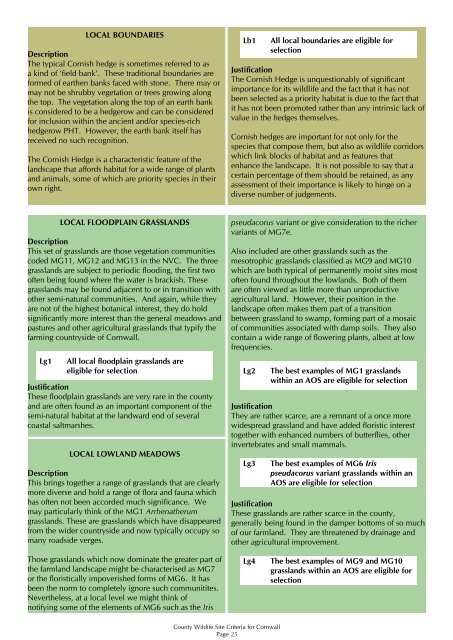County Wildife Site Criteria for Cornwall - Cornwall Wildlife Trust
County Wildife Site Criteria for Cornwall - Cornwall Wildlife Trust
County Wildife Site Criteria for Cornwall - Cornwall Wildlife Trust
Create successful ePaper yourself
Turn your PDF publications into a flip-book with our unique Google optimized e-Paper software.
LOCAL BOUNDARIESDescriptionThe typical Cornish hedge is sometimes referred to asa kind of ‘field bank’. These traditional boundaries are<strong>for</strong>med of earthen banks faced with stone. There may ormay not be shrubby vegetation or trees growing alongthe top. The vegetation along the top of an earth bankis considered to be a hedgerow and can be considered<strong>for</strong> inclusion within the ancient and/or species-richhedgerow PHT. However, the earth bank itself hasreceived no such recognition.The Cornish Hedge is a characteristic feature of thelandscape that af<strong>for</strong>ds habitat <strong>for</strong> a wide range of plantsand animals, some of which are priority species in theirown right.Lb1All local boundaries are eligible <strong>for</strong>selectionJustificationThe Cornish Hedge is unquestionably of significantimportance <strong>for</strong> its wildlife and the fact that it has notbeen selected as a priority habitat is due to the fact thatit has not been promoted rather than any intrinsic lack ofvalue in the hedges themselves.Cornish hedges are important <strong>for</strong> not only <strong>for</strong> thespecies that compose them, but also as wildlife corridorswhich link blocks of habitat and as features thatenhance the landscape. It is not possible to say that acertain percentage of them should be retained, as anyassessment of their importance is likely to hinge on adiverse number of judgements.LOCAL FLOODPLAIN GRASSLANDSDescriptionThis set of grasslands are those vegetation communitiescoded MG11, MG12 and MG13 in the NVC. The threegrasslands are subject to periodic flooding, the first twooften being found where the water is brackish. Thesegrasslands may be found adjacent to or in transition withother semi-natural communities. And again, while theyare not of the highest botanical interest, they do holdsignificantly more interest than the general meadows andpastures and other agricultural grasslands that typify thefarming countryside of <strong>Cornwall</strong>.Lg1All local floodplain grasslands areeligible <strong>for</strong> selectionJustificationThese floodplain grasslands are very rare in the countyand are often found as an important component of thesemi-natural habitat at the landward end of severalcoastal saltmarshes.LOCAL LOWLAND MEADOWSDescriptionThis brings together a range of grasslands that are clearlymore diverse and hold a range of flora and fauna whichhas often not been accorded much significance. Wemay particularly think of the MG1 Arrhenatherumgrasslands. These are grasslands which have disappearedfrom the wider countryside and now typically occupy somany roadside verges.pseudacorus variant or give consideration to the richervariants of MG7e.Also included are other grasslands such as themesotrophic grasslands classified as MG9 and MG10which are both typical of permanently moist sites mostoften found throughout the lowlands. Both of themare often viewed as little more than unproductiveagricultural land. However, their position in thelandscape often makes them part of a transitionbetween grassland to swamp, <strong>for</strong>ming part of a mosaicof communities associated with damp soils. They alsocontain a wide range of flowering plants, albeit at lowfrequencies.Lg2The best examples of MG1 grasslandswithin an AOS are eligible <strong>for</strong> selectionJustificationThey are rather scarce, are a remnant of a once morewidespread grassland and have added floristic interesttogether with enhanced numbers of butterflies, otherinvertebrates and small mammals.Lg3The best examples of MG6 Irispseudacorus variant grasslands within anAOS are eligible <strong>for</strong> selectionJustificationThese grasslands are rather scarce in the county,generally being found in the damper bottoms of so muchof our farmland. They are threatened by drainage andother agricultural improvement.Those grasslands which now dominate the greater part ofthe farmland landscape might be characterised as MG7or the floristically impoverished <strong>for</strong>ms of MG6. It hasbeen the norm to completely ignore such communitites.Nevertheless, at a local level we might think ofnotifying some of the elements of MG6 such as the IrisLg4The best examples of MG9 and MG10grasslands within an AOS are eligible <strong>for</strong>selection<strong>County</strong> <strong>Wildife</strong> <strong>Site</strong> <strong>Criteria</strong> <strong>for</strong> <strong>Cornwall</strong>Page 25
















